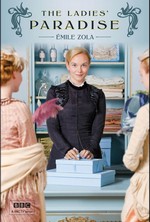The Ladies' Paradise (BBC tie-in) (Oxford World's Classics)
The Ladies’ Paradise is an important text, for, whereas Pot-Bouille had concentrated on the private lives of the bourgeoisie, its sequel marks Zola’s desire to broaden his social perspective and embrace the whole of socio-economic reality through his representation of the world of the department store. The model for Mouret’s store is the Bon Marché, Paris’s first department store and the largest single department store in the world before 1914.1 Aristide Boucicaut took over the Bon Marché, a large drapery shop, in 1852 and quickly transformed it into a much larger shop. In 1852 it boasted four departments, twelve employees, and a turnover of 450,000 francs a year. Its turnover rose to 5 million in 1860, 7 million in 1863, 21 million in 1869, 77 million in 1877, more than 80 million in 1882, 123 million in 1888, and over 200 million in 1906. The physical expansion of the store was equally impressive. When Boucicaut stopped building in 1887, it occupied a whole city block. The establishment of the Bon Marché as a grand magasin was followed by that of the Bazar de l’Hôtel de Ville in 1854, Les Grands Magasins du Louvre (usually just called Le Louvre) in 1855, Au Coin de la Rue in 1864, Au Printemps in 1865, La Belle Jardinière in 1866–7, La Samaritaine in 1869, and Les Galeries Lafayette in 1895. There were parallel developments of course in the United States and England—Macy’s in New York, Marshall Field in Chicago, Wanamaker’s in Philadelphia, Selfridge’s in London. In his preparation for the novel Zola visited the Bon Marché and Le Louvre, took notes, and consulted with various authorities, including former employees of department stores and the architect Frantz Jourdain, a pioneer designer of this sort of establishment. ‘What I want to do in The Ladies’ Paradise’, Zola wrote in his notes, ‘is write the poem of modern activity. Hence, a complete shift of philosophy: no more pessimism, first of all. Don’t conclude with the stupidity and sadness of life. Instead, conclude with its continual labour, the power and gaiety that comes from its productivity. In a word, go along with the century, express the century, which is a century of action and conquest, of effort in every direction.’2 Despite the destruction of many of the traditional little family shops, The Ladies’ Paradise is a hymn to modern business, a celebration of the entrepreneurial spirit...














